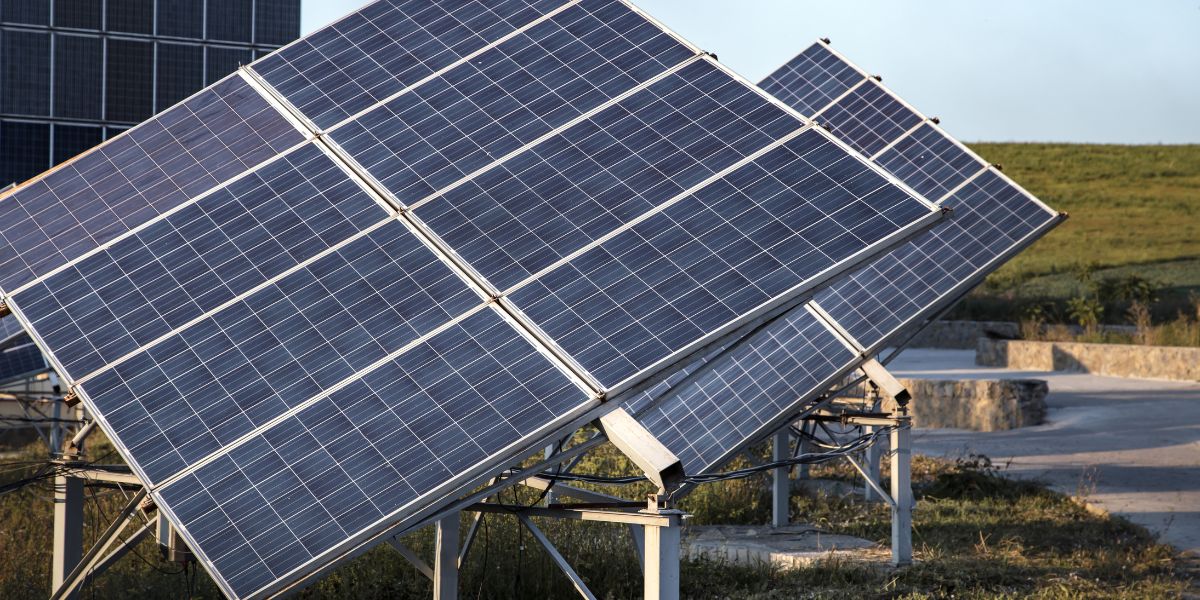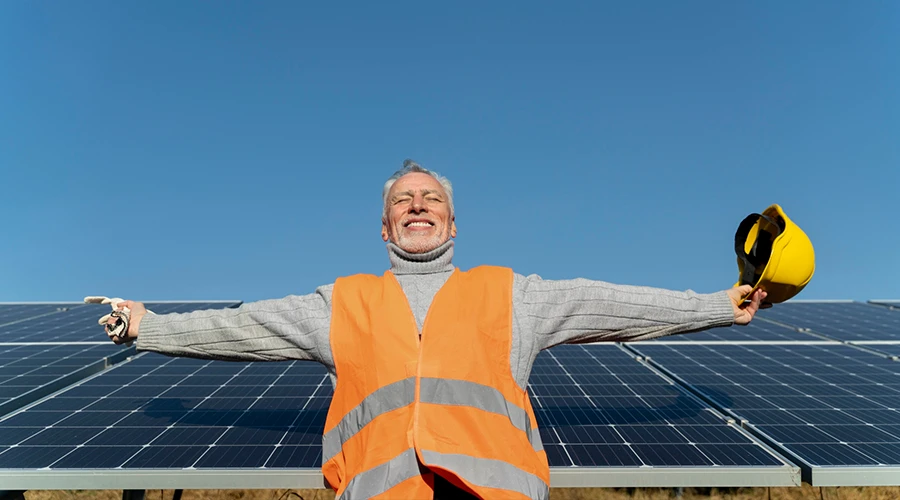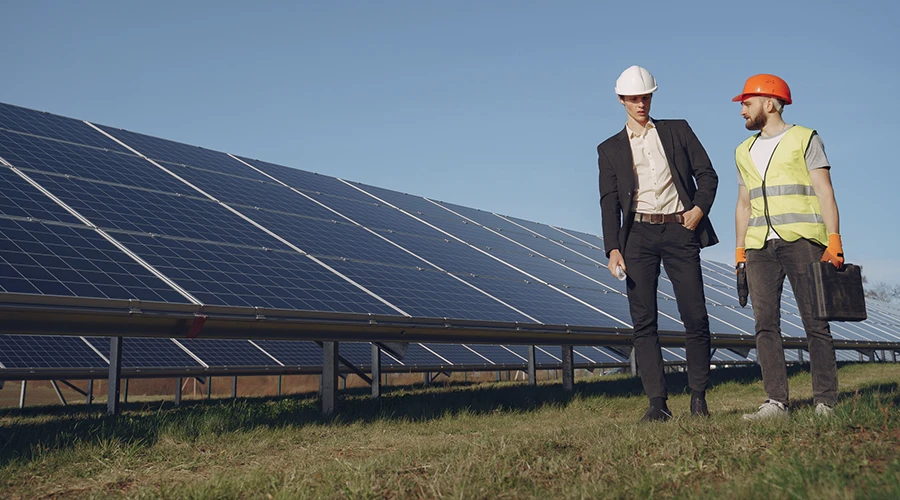You’re probably here because you’re considering solar panels for your home in Australia, (and more specifically on the Sunshine Coast and SEQ) so you really need to understand the best solar panel direction and orientation to maximise your solar output. The direction your solar panels face can significantly impact their performance, especially in regions like the Sunshine Coast and Queensland. This guide will help you determine the ideal solar panel direction and how to optimize their angle for maximum energy production.
It’s worth stating the obvious here: The better you orient your panels, in consideration of your energy use, roof orientation, angle of panels and so on, the more power you will generate and the more money you will save by harnessing the sun’s energy.
Understanding Solar Panel Orientation
The solar panel setup is a key factor in harnessing solar energy effectively. Generally, north facing panels are considered the ideal choice in the southern hemisphere, as it provides maximum exposure to sunlight throughout the day. However, if your roof doesn’t have suitable north-facing space, it’s comforting to know that you still have viable options.
When reading the alternatives, it’s important to consider shading as well. If many trees block the sun’s rays to your north-facing roof, then you may need to consider other roof inclines to house your panels. Let’s take a look.
Why Face North?
Northward-facing panels receive direct sunlight for most of the day, leading to higher energy production. If your roof faces north, expect optimal solar energy production. This is especially important for reducing your reliance on the grid and maximizing savings on your electricity bills.
What If You Can’t Face North?
If your roof can’t accommodate north-facing panels, consider panels that are east-facing or west-facing. Here’s how each option can benefit you:
- East-Facing Panels: These panels generate more energy in the morning. If you use more electricity during the day, this could be a good option for you.
- West-Facing Panels: These are advantageous if your household consumes more power in the afternoon and evening. If you’re on a time-of-use tariff, panels aligned to the west can help you save money during peak hours.
The Worst Direction to Install Solar Panels
It’s essential to note that south-facing panels are generally considered the worst way to orient your panels for solar energy production in Australia. (Of course, the opposite is true in the northern hemisphere.) While they can still generate some energy, they will likely underperform compared to panels facing north, east, or west.
The Optimal Angle for Solar Panels
Along with the direction of solar panels, the angle at which they are installed significantly affects efficiency. Ideally, solar panels should be tilted at an angle close to your latitude. For most locations in Queensland, including the Sunshine Coast, this angle is typically between 30 and 35 degrees. Proper panel direction and tilt ensure that your panels receive maximum sunlight, and this enhances their ability to generate solar power.
Compromises Versus the Perfect Installation
Look, I could go crazy and show you diagram after diagram of the changes of the sun in your area. But ultimately, you need to assess everything to create the best system you can. Angle, shade, alignment of different roof spaces in relation to the sun (at different times of the day), usage, whether aesthetics and avoiding racking for panels is important to you… Most houses do not face due north perfectly, or have that ideal 30ish degree angle. There will always be compromises. You need an honest solar installer or technician to help you plan your optimal system.
Adjusting for Roof Pitch and Seasonal Changes
Theoretically, you could adjust the tilt of your panels seasonally to optimize performance year-round. In regions like Queensland, where sunlight exposure varies, minor adjustments could significantly enhance energy capture.
But honestly, that’s not a practical solution. You need to be happy with a middle ground approach and balance all the inputs to create the best outcome for your home or business premises. For example, if you have a roof with a low pitch of 12 degrees, you would explore the notion of creating the ideal 30 degree angle with racks designed to improve the angle. However, if your roof gets no shade on it at all, you could install a slightly larger capacity system to make up for the pitch. Even with extra panels, you’ll have a cheaper, more attractive installation and will avoid the disadvantages of racking. As I said, you have to weigh your options. For me, practicality wins out!
Factors Influencing Solar Panel Direction
When deciding on the right orientation for solar panels, consider the following factors:
- Shading: Ensure that your chosen positioning is free from shading caused by trees, buildings, or other obstacles. Even partial shading can drastically reduce solar output. Conduct a shading analysis to identify potential issues. Even satellite dishes, or antennae can throw a shadow that would interrupt energy production. You can work around these, or shift the infrastructure.
- Local Climate: Research local weather patterns specific to the Sunshine Coast. For instance, if mornings tend to be cloudier, west-facing panels might perform better in your area.
- Household Energy Use: Analyse your energy consumption patterns. If your usage peaks in the evening, west-facing panels are likely the better choice. Keep in mind, you can have a mixture of directions. Many owners install panels on different facets of their roofs, not just for orientation, but because they are trying to maximise the number of panels.
- Solar Feed-In Tariffs: Understand your local feed-in tariff system. Some tariffs incentivise energy production during specific times of day, which can influence your panel position. There’s a great website that can help you find the best electricity plan in your area. Go to https://www.energymadeeasy.gov.au/ . The service starts with you filling in your postcode. At the other end you’ll be able to compare plans that suit your power usage.
Local Insights for Queensland Residents
In Queensland, you can expect an average of 5-7 hours of peak sunlight each day, especially in the summer months. This means that choosing the right solar panel angle and orientation is essential for you to maximise your investment. As I’ve said above, if you do have the option, you’ll do well to install north-facing panels because overall, they yield the best results. However, if your roof faces east or west, make sure you understand your household’s energy usage so you can make the best decision.
Expert Recommendations
Consult with local solar installers to get tailored advice for your specific situation. They can provide insights based on your roof’s orientation, shading, and local climate to ensure you get the most out of your solar system. And that’s exactly what we’ll do when you ring us at SWIFT SOLAR & Electrical! (0422 251 734). We’ll take you through our specially designed process of getting solar installed. We take into account the best way to face solar panels, (and the worst direction solar panels too) sun exposure to the panels, orientation and tilt, budget, power requirements, whether you want to integrate batteries, charge EVs, and so much more. You’ll end up with the right system for you.
Maximize Your Solar Energy: Key Takeaways for Optimal Panel Orientation and Angle
When you take the plunge and decide to go solar, it’s important to choose the right solar panel direction . It’s one of the best ways to maximise your investment in solar energy. In Australia, panels aligned to the north are typically the best option, but east and west orientations can also be effective based on your specific needs. Always consider factors like shading, local climate, and energy consumption patterns when determining the best direction for solar panels for your home.
With over four million solar installations across Australia, it’s easy to see how solar electricity has become a big thing! In other articles, we’ll explore solar and battery systems. When you involve batteries, you get to use excess solar that you generated, at a time when the sun doesn’t shine. More of that another time!
Take all the prevailing issues into account, then you can ensure that your solar panels are optimally positioned to provide you with the greatest benefit. Whether you aim to reduce your electricity bills or contribute to a more sustainable future, understanding how to orient your solar panels is a key step in your solar journey. Install solar panels that truly maximize the sun’s energy! We’d be delighted to help you make the right decisions to suit your unique situation! Call us on 0422 215 734 at SWIFT SOLAR & Electrical.



